In the competitive world of road cycling, weight, performance, and value often exist in a delicate balance. The Trifox X16TA Disc Brake Lightweight Carbon Road Bike Frame disrupts this equation by offering exceptional quality at an accessible price point. With impressive weight specifications, comprehensive sizing, and modern features, this frame has garnered attention from builders seeking professional-level performance without the premium price tag.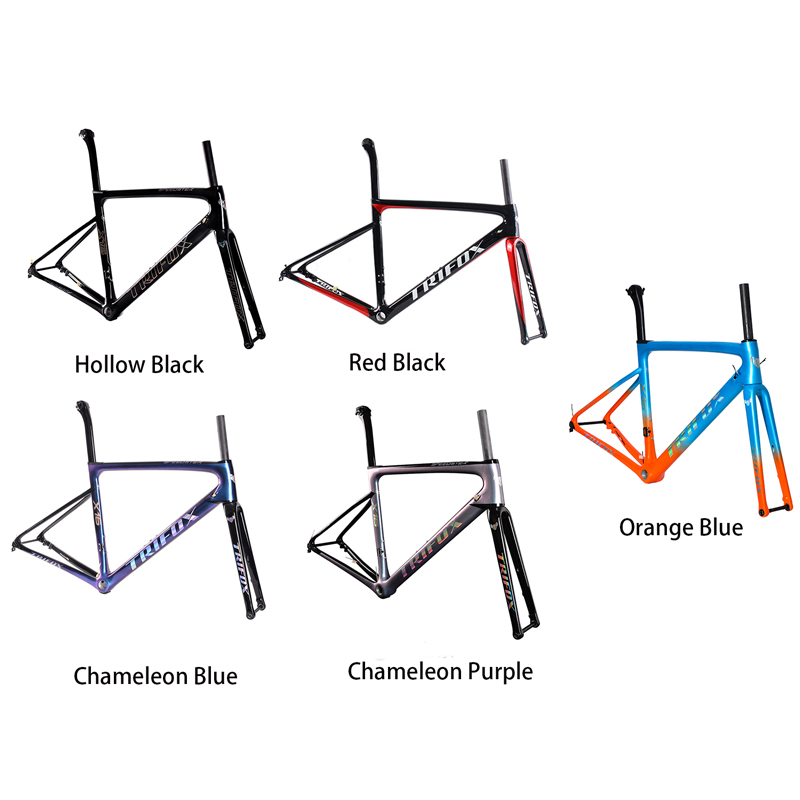
Impressive Weight Savings: From Frame to Complete Build
The weight specifications of the X16TA immediately stand out. At just 971g ± 30g for the popular 44cm size, this lightweight bike frame demonstrates what modern carbon manufacturing can achieve. Documented builds using this frame have achieved complete 7kg road bike weights—an impressive feat that places these builds in the same weight category as bikes costing significantly more. This lightweight characteristic doesn't come at the expense of durability, with the carbon fiber layup providing optimal stiffness for power transfer while maintaining sufficient compliance for rider comfort.
Geometry Optimized for Performance Riding
The X16TA features geometry designed for performance-oriented riding rather than endurance-focused comfort. The carefully calculated angles and tube lengths create a balanced position that's aggressive enough for fast group rides and racing while remaining manageable for most fit riders. This is a true racing bike frame designed for riders who want a responsive, race-ready platform, with comprehensive sizing ensuring most riders can find their perfect fit.
Aesthetic Appeal & Technical Specifications
Visual design plays a significant role, and the X16TA offers appealing options including the previously popular color-shifting blue and the new blue-orange color scheme. The frame features semi-internal routing that keeps the cockpit tidy while maintaining accessibility for maintenance. The frame accommodates tires up to 700C x 28mm and supports both electronic (including Shimano Di2) and mechanical groupsets, offering builders maximum flexibility in component selection.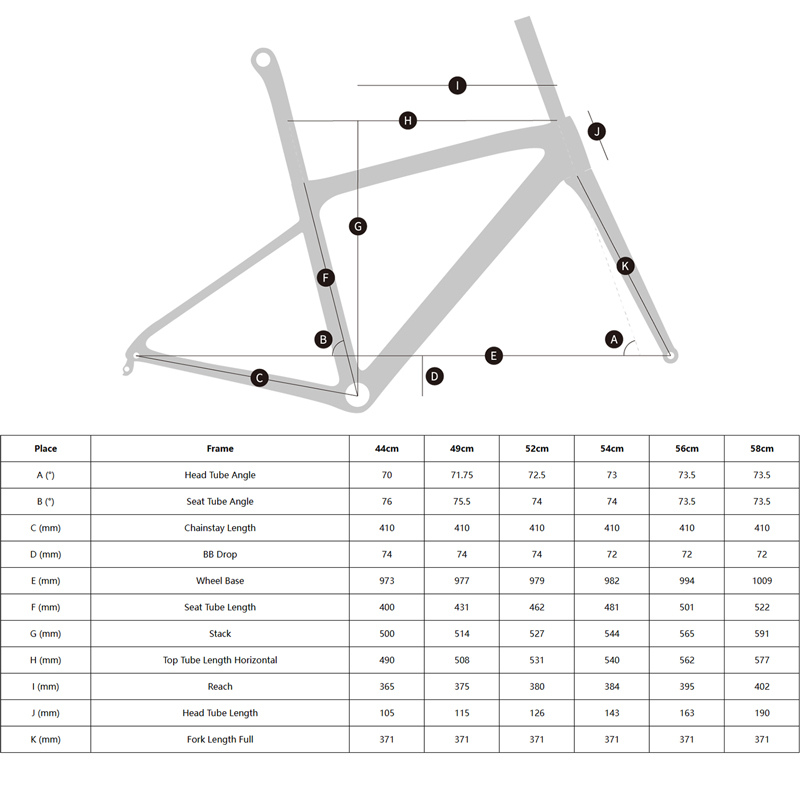
Complete Package & Riding Experience
Unlike many frames sold separately, the X16TA typically comes as a complete road bike frameset including frame, fork, and seatpost. This comprehensive offering represents significant value, as these components are carefully matched to work together optimally. On the road, the X16TA delivers the responsive, lively feel that performance-oriented riders seek, with the disc brake road frame compatibility enhancing the riding experience with consistent, powerful braking in all conditions.
Value Proposition: Performance Within Reach
Perhaps the most compelling aspect of the X16TA is its value proposition as an affordable carbon frame. By offering a lightweight, well-designed carbon frame with modern features at an accessible price point, it opens high-performance road cycling to more enthusiasts. For riders who want to allocate more of their budget toward high-quality components rather than an expensive frame, the X16TA represents an intelligent choice that provides a solid foundation without compromising essential performance characteristics.
Conclusion: A Strong Contender in the Value Segment
The Trifox X16TA Carbon Frame successfully addresses multiple needs for performance-oriented cyclists. Its light weight, comprehensive sizing, attractive color options, and thoughtful technical specifications combine to create a compelling package. For builders seeking a high-quality carbon foundation without the premium price tag, or for riders wanting to experience the benefits of modern carbon frame technology, the X16TA represents an excellent performance road frame option that makes high-quality road cycling more accessible to dedicated enthusiasts.
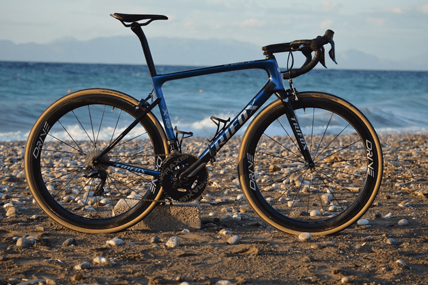
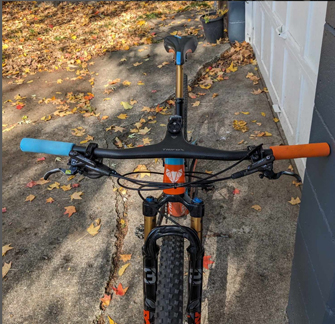
In the quest for a cleaner cockpit and enhanced performance, integrated handlebars have become the upgrade of choice for discerning mountain bikers. Trifox offers two excellent options in this category: the RHB200 and RHB600. Both are carbon fiber integrated MTB handlebars designed to improve your bike's front end, but they feature key differences that cater to varying preferences and needs. Understanding these distinctions will help you select the perfect cockpit upgrade for your trail adventures.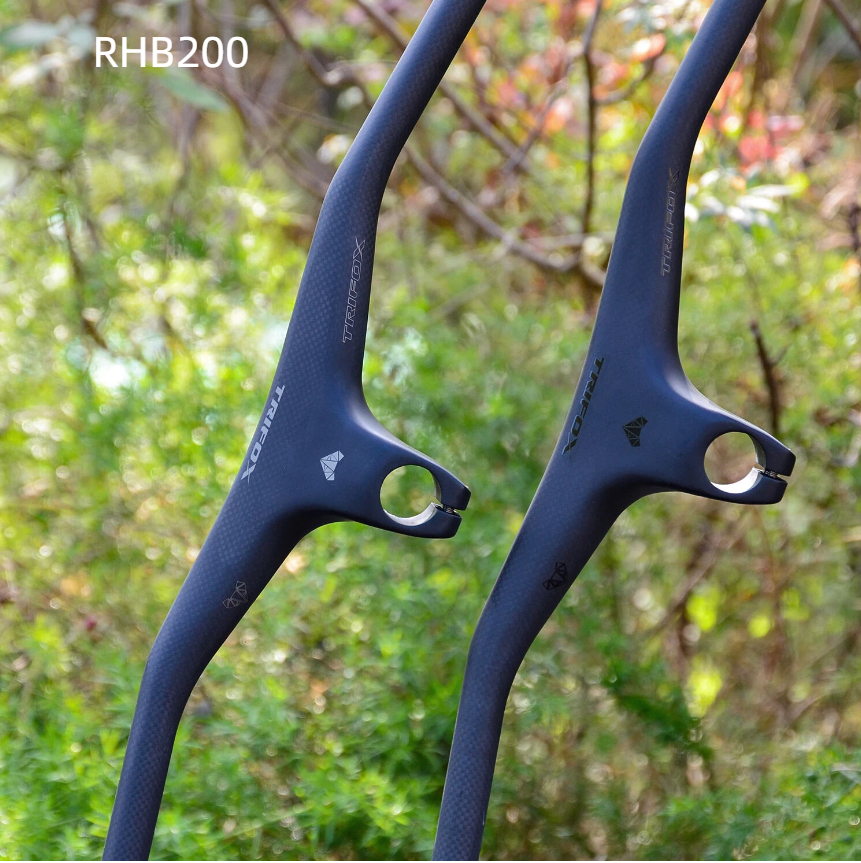
Design & Construction: Carbon Excellence for Mountain Biking
Both the Trifox RHB200 and RHB600 utilize high-quality carbon fiber construction, offering the ideal balance of lightweight performance and trail-ready durability. As carbon mtb handlebars, they provide superior vibration damping compared to aluminum alternatives, reducing hand fatigue on long rides while maintaining the stiffness needed for precise control in technical sections.
Geometry & Fit: Tailored for Trail Performance
Both handlebars are designed specifically as mountain bike riser handlebars with ergonomic geometries optimized for off-road riding. They feature moderate rise (typically 20-35mm) and backsweep (8-9 degrees) that position your hands naturally for control and comfort during long trail sessions. Both models represent excellent choices for riders seeking responsive mtb bicycle handlebars.
Cable Management: The Defining Difference
This is where the two models diverge most significantly, representing different approaches to cockpit cleanliness and maintenance accessibility.
The RHB200 Carbon Integrated MTB Handlebar utilizes a semi-integrated routing approach. While it features clean entry and exit points for cables, some cable housing may remain partially visible along the bar and stem interface. This design offers easier installation and maintenance while still providing a cleaner look than traditional separate components.
The RHB600 Carbon Integrated Full Internal MTB Handlebar represents the pinnacle of cockpit integration. All brake lines, derailleur cables, and dropper post housings route completely internally through the bar and stem structure. This full internal routing creates an exceptionally clean appearance while protecting cables from trail debris and weather elements. This makes the RHB600 a superior choice for those seeking the ultimate in internal cable routing solutions.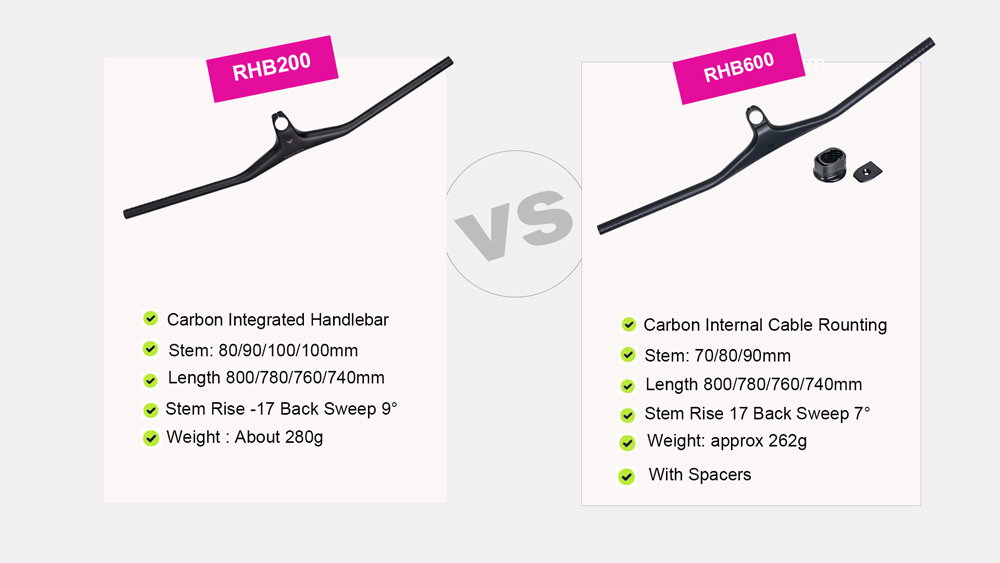
Weight & Performance Considerations
As lightweight mtb cockpit solutions, both bars offer significant weight savings over traditional setups. The RHB200 typically weighs between 260-300g (depending on width), making it a noticeable upgrade for riders seeking to reduce front-end weight without compromising strength.
The RHB600, with its additional material for internal routing channels, still very light (approximately 240-290g) and represents a significant improvement over non-integrated alternatives. Both models provide the responsive handling characteristics that serious mountain bikers demand from their mtb bars.
Compatibility & Installation
Both Trifox handlebars are designed for modern mountain bikes with tapered steerer tubes. The integrated stem lengths vary between models and within each product line to accommodate different bike geometries and rider preferences.
The RHB200 offers relatively straightforward installation similar to traditional handlebars, making it accessible for most home mechanics. The RHB600 requires more careful installation due to its internal routing system but rewards users with the cleanest possible cockpit aesthetic.
Value Proposition: Which Bar Is Right for You?
The choice between these two excellent carbon mtb handlebars comes down to your priorities for aesthetics, maintenance preferences, and budget.
Choose the Trifox RHB200 if you want a significant cockpit upgrade at a more accessible price point, value easier installation and maintenance, appreciate cleaner aesthetics but don't require complete cable concealment, or are building or upgrading a trail bike where value and performance balance matters.
Choose the Trifox RHB600 if you demand the cleanest possible cockpit appearance with full cable integration, prioritize modern, sleek aesthetics, don't mind the additional complexity of internal routing installation, or are creating a high-end build where every detail contributes to the overall premium appearance.
Both the RHB200 and RHB600 deliver exceptional value in their respective categories, offering the performance benefits of carbon fiber construction with improved integration over traditional setups. Whether you choose the accessibility of the RHB200 or the ultimate integration of the RHB600, you'll be upgrading to a cockpit that enhances both the performance and appearance of your mountain bike.

In the world of road cycling, finding the perfect balance between high-performance engineering and everyday practicality can seem like an impossible quest. The Trifox 700C Ultralight Carbon Fiber Road Bike with its S-RIDE 2x11-speed groupset and disc brakes represents that rare sweet spot where race-ready capability meets real-world usability.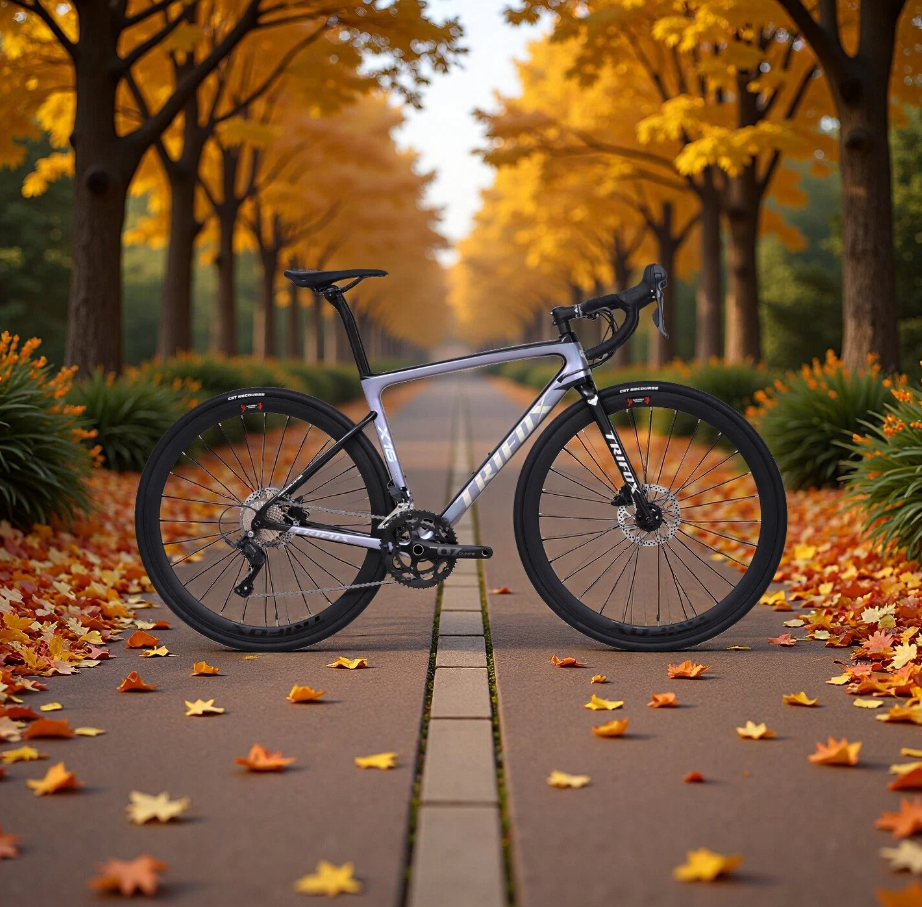
The Carbon Frame Advantage: Lightweight Yet Durable
At the heart of this remarkable machine lies its full carbon frame road bike construction. Unlike heavier alternatives, this lightweight road bike frame delivers the stiffness-to-weight ratio that serious cyclists demand. What makes this particular frame special is its versatility – the geometry works equally well as a responsive racing bicycle for competitive events or as a comfortable bicycle road bike for weekend adventures.
11-Speed Gearing: The Perfect Balance of Range and Simplicity
The 2x11-speed drivetrain represents the ideal compromise in modern road cycling. With 22 available gears, riders have ample range to tackle steep climbs while maintaining optimal cadence on flat sprints. This gearing setup provides the versatility needed for varied terrain without the complexity and weight of more extreme systems.
Disc Brakes: Reliable Stopping Power in All Conditions
One of the most significant practical advantages of this bike is its hydraulic disc brake system. Unlike traditional rim brakes that can suffer in wet conditions, these disc brakes provide consistent, powerful stopping regardless of weather. This safety feature is particularly valuable for riders who commute on their road bikes or ride in changeable conditions.
Designed for Real Riders
The thoughtful design extends to every aspect of this bike. The classic bike with drop bars offers multiple hand positions for comfort during long rides, while the carbon frame's geometry accommodates a wide range of body types, making it an excellent option as a womens road bike with appropriate sizing.
Exceptional Value Proposition
Perhaps most impressively, this bike achieves all this while remaining among the more inexpensive road bikes with genuine carbon construction. By combining a quality carbon frame with proven componentry, Trifox has created a road racing bicycle that delivers 90% of the performance of bikes costing twice as much.
The Complete Package for Modern Cycling
From its responsive carbon frame to its reliable disc brakes and versatile 11-speed gearing, every component of this bike has been selected to create a harmonious whole. It's a carbon frame road bike that doesn't force you to choose between speed and comfort, between performance and practicality.
The Trifox 700C Carbon Road Bike proves that you don't need to compromise to get a truly exceptional riding experience. By thoughtfully combining modern materials with sensible design choices, it delivers the performance that excites serious cyclists while maintaining the practical features that make cycling accessible and enjoyable for everyone.
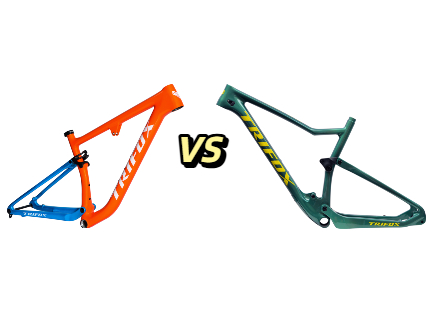
Selecting the perfect full-suspension carbon frame involves balancing multiple technical factors that directly impact your riding experience. Trifox offers two exceptional but distinct options: the Trail II Pro and the MFM100. Both utilize high-modulus carbon fiber and modern engineering, yet differ significantly in their approach to geometry, suspension design, and component compatibility. Understanding these differences will help you choose the frame that best matches your riding style and trail requirements.
Geometry & Riding Position: XC Efficiency vs Trail Confidence
The MFM100 is engineered for cross-country performance. Its geometry features a steeper head tube angle (around 68–69°) and a shorter reach, creating an upright, efficient pedaling position ideal for climbing and accelerating on undulating terrain. This is a classic XC mountain bike frame philosophy—prioritizing speed and efficiency over sheer stability.
Conversely, the Trail II Pro embraces modern trail bike geometry. With a slacker head tube angle (approximately 67–68°) and a longer front center, it positions the rider lower and further between the wheels. This "in-the-bike" stance inspires confidence on steep descents and provides superior stability at high speeds, making it the clear choice for technical, aggressive trail riding.
Suspension Design & Installation: A Key Differentiator
Here lies a major technical distinction. While both frames use a sophisticated four-bar linkage system, their suspension design and shock installation differ to serve their intended purposes.
The Trail II Pro typically employs a more traditional shock mount placement, with the shock oriented vertically or at a slight angle between the top tube and the seat stay/chainstay intersection. This layout prioritizes a linear to moderately progressive curve, focusing on pedaling efficiency, mid-stroke support, and quick recovery—perfect for maintaining momentum on climbs and flow trails.
The MFM100 often features a low main pivot design with the shock mounted lower in the frame, between the down tube and the front of the swingarm. This configuration, combined with a higher leverage ratio, creates a more progressive suspension curve. It offers greater small-bump sensitivity for traction and ramps up significantly at the end of the travel to handle big impacts without bottoming out harshly. This design favors descending capability and all-mountain performance.
Rear Derailleur Hanger: The Critical Link to Your Drivetrain Choice
This is a core difference that affects your drivetrain selection and future upgrade path.
The Trail II Pro is equipped with a UDH (Universal Derailleur Hanger). This design provides a crucial compatibility advantage. The UDH hanger is a mandatory requirement for installing the SRAM Eagle Transmission groupset—a widely used and beloved wireless electronic shifting system known for its extreme performance, reliability, and simplicity. At the same time, the UDH is fully compatible with all traditional Shimano and SRAM mechanical or electronic derailleurs. Choosing the Trail II Pro means you can freely select any mainstream groupset available today and also have the door open for a future seamless upgrade to the top-tier SRAM Eagle Transmission, ensuring the frame's long-term value and technical foresight.
The MFM100 uses a standard, model-specific hanger. This traditional hanger can reliably support Shimano groupsets and all SRAM traditional groupsets except for the SRAM Eagle Transmission. However, it cannot be compatible with the UDH-mandatory SRAM Eagle Transmission. This means that if you wish to upgrade to this popular high-performance wireless groupset in the future, you will be limited. Furthermore, if damaged, you must find a specific replacement that exactly matches this frame model.
Weight & Construction Philosophy
Adhering to its XC racing pedigree, the Trail II Pro is the lighterweight carbon frame. Its carbon layup is optimized to shed every possible gram while maintaining precise stiffness for efficient power transfer. It’s designed for riders who count grams and value snappy acceleration.
The MFM100, built to endure the rigors of trail and all-mountain abuse, carries a slight weight penalty. This extra mass comes from strategic reinforcement at high-stress points (like the suspension pivots and chainstay yoke) to ensure long-term durability and impact resistance. The weight is a worthwhile trade-off for the resilience it provides.
Aesthetic & Color Options
Visual identity aligns with each frame's purpose. The Trail II Pro often comes in understated, professional color schemes like matte black, charcoal, or navy—reflecting its racing heritage. The MFM100 tends to offer more vibrant, adventurous finishes, such as glossy electric blue, matte olive green, or two-tone combinations, mirroring its trail-ready character.
The Verdict
Your choice fundamentally depends on your local trails and riding priorities.
- Choose the Trifox Trail II Pro if: You live for climbs, value every gram, participate in XC events, or ride trails where pedaling efficiency and quick handling are paramount. Its efficient suspension and lighter weight make it a rocket on climbs and flowing singletrack. The inclusion of the UDH also makes it the only choice if you plan to use or upgrade to the SRAM Eagle Transmission groupset.
- Choose the Trifox MFM100 if: Your rides feature challenging descents, technical features, and varied terrain. You value stability, traction, and impact absorption. The progressive suspension and modern geometry make it a robust and confident partner for trail adventures, provided you do not require compatibility with the SRAM Eagle Transmission.
Both frames exemplify Trifox's commitment to quality carbon engineering. By carefully weighing their differences in geometry, suspension design, and critical details like the derailleur hanger standard, you can select the carbon foundation that will transform your vision of the perfect mountain bike into reality.
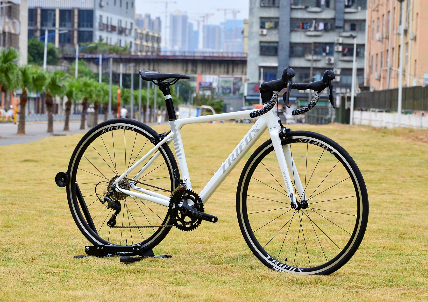
Finding the perfect balance between affordability and performance can be challenging for new road cyclists. The Trifox C-Brake Ultralight Aluminium Frame Road Bike strikes this balance beautifully, offering professional-level features at an accessible price point that's winning over beginners and experienced riders alike.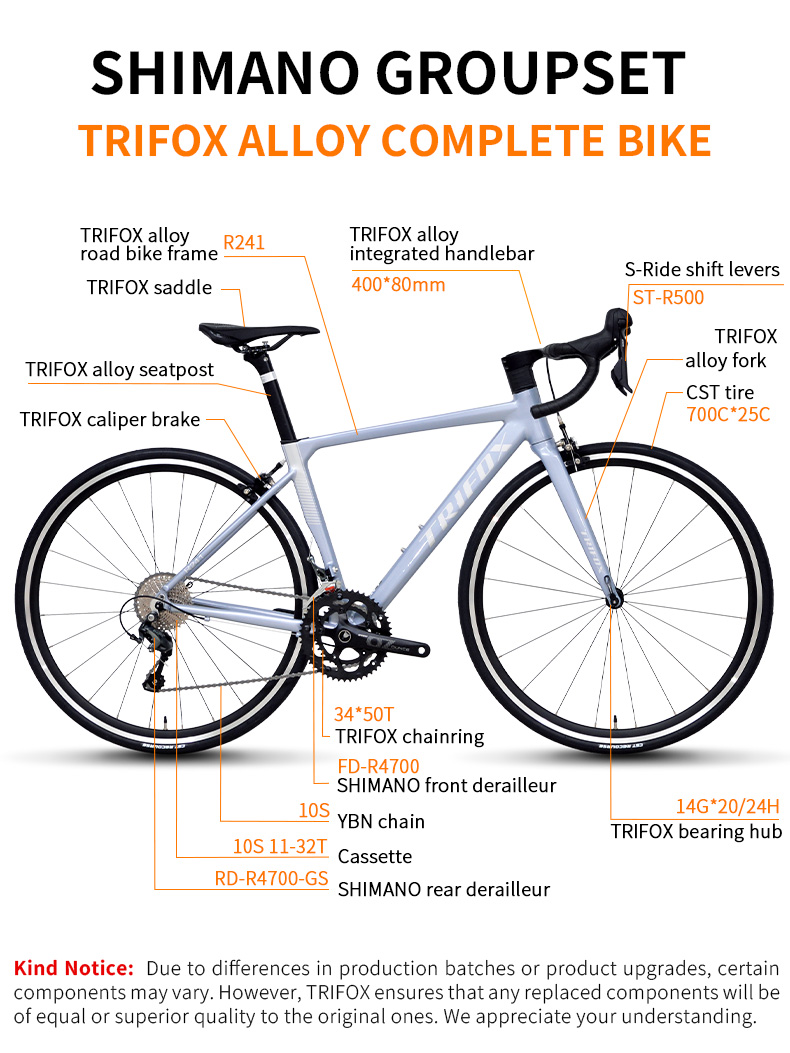
The Perfect Entry Point to Road Cycling
For those starting their cycling journey, this model stands out as one of the best entry level road bike options available. The lightweight aluminum frame provides the responsive ride quality that new cyclists seek, while the proven Shimano Tiagra groupset ensures reliable performance mile after mile. What makes this particular aluminum road bicycle special is its ability to deliver genuine road cycling excitement without the intimidating price tag of professional racing bikes.
Designed for Performance and Comfort
The frame geometry strikes an ideal balance between aggressive racing positions and comfortable endurance riding. This makes it an excellent choice as a ladies road bike, with sizing options that accommodate different body types and riding styles. The aero road bike inspired tube shaping not only looks fast but actually improves airflow around the bike, giving you an efficiency advantage whether you're keeping up with group rides or pushing for personal bests.
Quality Components That Matter
While some budget bikes cut corners on components, this alu road bike features a complete Shimano Tiagra 4700 2x10-speed groupset. The precise shifting and reliable braking performance give new riders the confidence to focus on developing their skills rather than fighting with their equipment. The combination of quality components and thoughtful frame design creates a racing bicycle experience that feels far more expensive than its actual price point.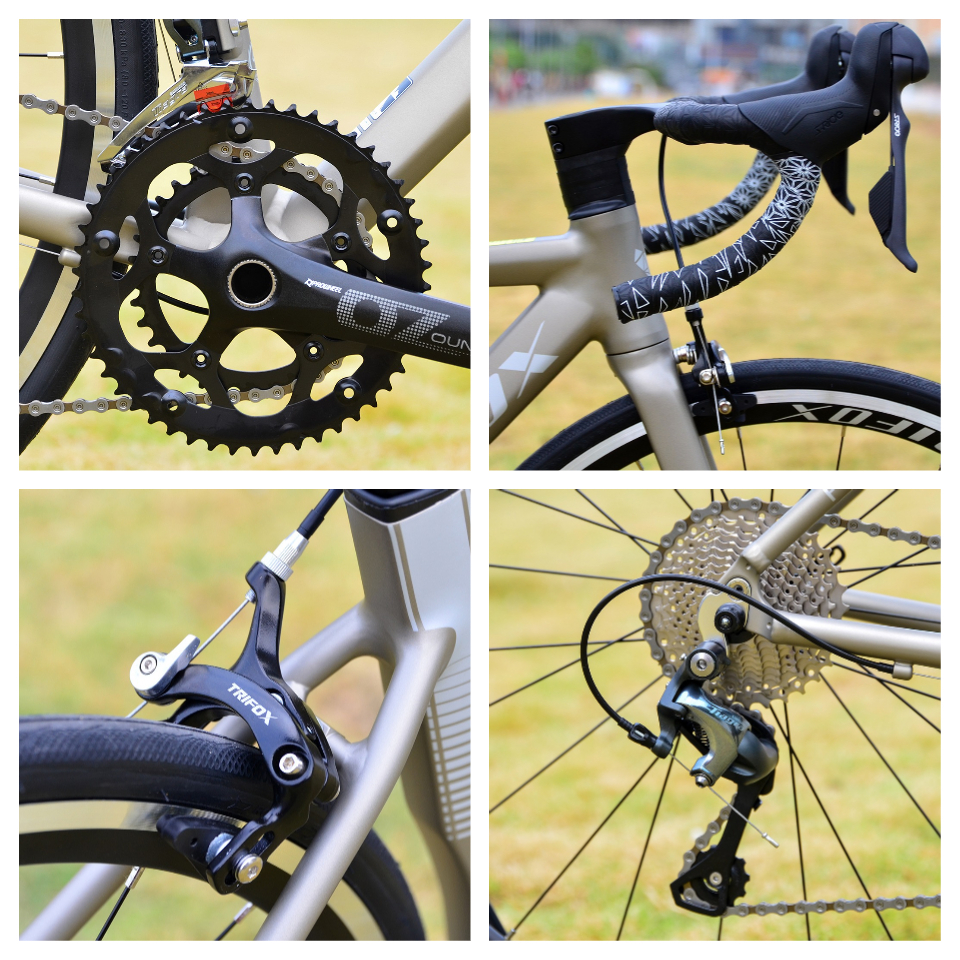
Versatility for Different Riding Styles
One of the bike's strongest advantages is its adaptability to various riding disciplines. The responsive nature of the aluminum road bicycle makes it equally suitable for fast club rides, endurance events, or even entry-level racing. The balanced geometry provides stable handling for beginners while still offering the quick reflexes that experienced riders appreciate when pushing the pace.
Exceptional Value in Modern Road Biking
In an era where carbon fiber often dominates the spotlight, this bike proves that advanced alu road bike technology continues to offer incredible value. The modern aluminum manufacturing techniques create frames that are both lightweight and durable, perfect for riders who want a low-maintenance bike they can rely on season after season.
The Smart Choice for Growing Cyclists
For riders who may eventually progress to more specialized bikes, this model serves as the perfect foundation. The quality construction means it will maintain its value, while the reliable performance ensures it can serve as a dedicated training bike or foul-weather companion down the road. It's not just a beginner bike - it's a smart investment in your cycling future that will continue to deliver enjoyment as your skills and fitness improve.
The Trifox Aluminum Road Bike represents everything that's right about modern entry-level cycling. By combining quality materials, proven components, and thoughtful design at an accessible price, it removes barriers to entry while still delivering the authentic road cycling experience that turns newcomers into lifelong enthusiasts.
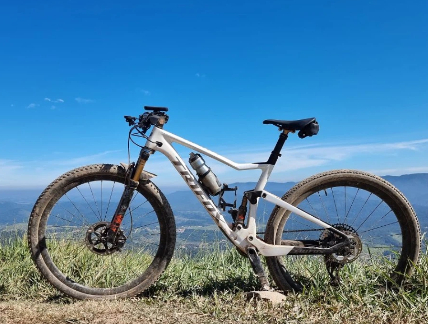
When it comes to conquering varied terrain, from steep technical climbs to flowing descents, having the right equipment makes all the difference. The Trifox 29er Carbon Full Suspension Trail Pioneer Bike represents the perfect balance of climbing efficiency and descending capability, making it an ideal choice for riders looking to master every aspect of trail riding.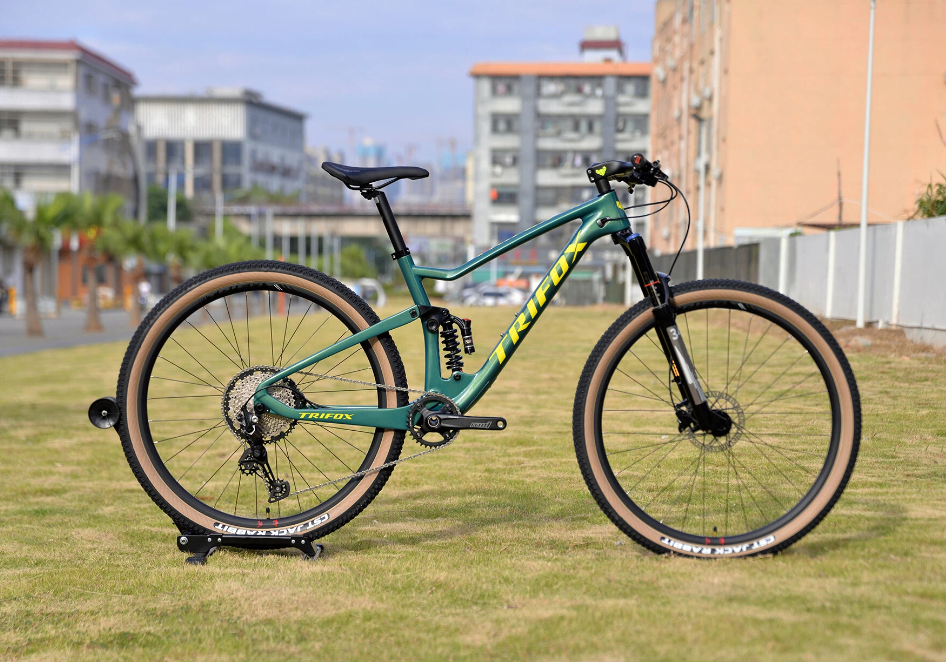
The Ultimate Trail Companion
A true full suspension trail bike needs to perform equally well going up as it does coming down. The Trifox Trail Pioneer excels in this regard, featuring a lightweight carbon frame that efficiently transfers power during climbs while the suspension system absorbs bumps and maintains traction. This combination makes it not just another mountain bike, but a genuine trail partner that enhances your riding experience regardless of the terrain.
Confidence-Inspiring Braking Performance
Modern trail riding demands reliable stopping power, and the mountain bike disc brakes on this bike deliver exactly that. Whether you're navigating technical rock gardens or carrying speed into bermed corners, the hydraulic disc brakes provide consistent modulation and power. This braking performance, combined with the bike's balanced geometry, gives riders the confidence to push their limits while maintaining full control.
Cross Country Performance Meets Trail Capability
While many bikes specialize in either climbing or descending, the Trifox Trail Pioneer truly bridges the gap between a pure cross country bike and a capable trail machine. The efficient pedaling platform and lightweight construction make it an excellent xc bike for covering long distances, while the generous suspension travel and modern geometry ensure it remains composed on challenging descents.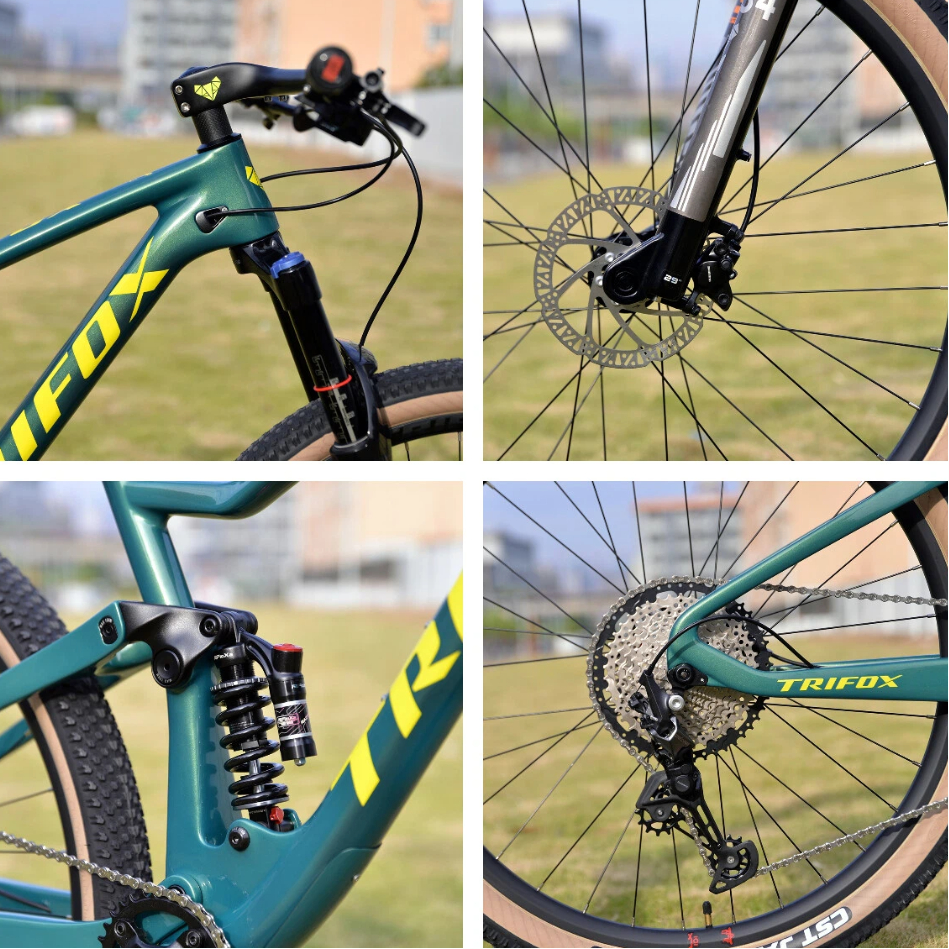
The 12-Speed Advantage
The inclusion of a 12-speed drivetrain significantly enhances the bike's capability across varying terrain. With a wider gear range than traditional systems, riders can tackle steep climbs without sacrificing top-end speed on flats and descents. The precise shifting and reliable performance of the 12-speed system ensure you're always in the right gear, whether you're grinding up a technical climb or accelerating out of corners.
Exceptional Value in Carbon Full-Suspension
Carbon full-suspension bikes often come with premium price tags, but the Trifox Trail Pioneer challenges this notion by offering what might be the cheapest full suspension mtb with genuine carbon construction and quality components. This accessibility means more riders can experience the benefits of a lightweight carbon frame and capable suspension without breaking the bank.
Ready for Whatever the Trail Throws at You
From rocky ascents that demand precise technical climbing to flowing descents where speed and control are paramount, this bike is designed to handle it all. The balanced suspension kinematics provide both pedaling efficiency and bump-eating compliance, while the carbon frame offers the perfect blend of stiffness and vibration damping. It's a bike that encourages progression and rewards skill development.
The Trifox 29er Carbon Full Suspension Trail Pioneer represents a new era of accessible high-performance mountain biking. By combining carbon construction, capable suspension, and modern components at an attractive price point, it removes barriers to entry for riders seeking to master all aspects of trail riding.
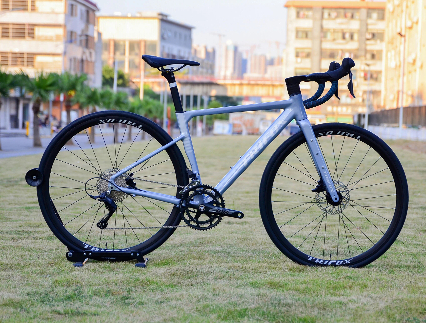
Stepping into the world of road cycling can be both exciting and overwhelming. With countless options available, choosing the right first bike becomes crucial to your cycling journey. The Trifox R241 700C Aluminium Frame Road Bike stands out as an exceptional choice, combining performance, reliability, and value in one package. Here's why a 22-speed disc brake aluminum road bike makes for the perfect first serious ride.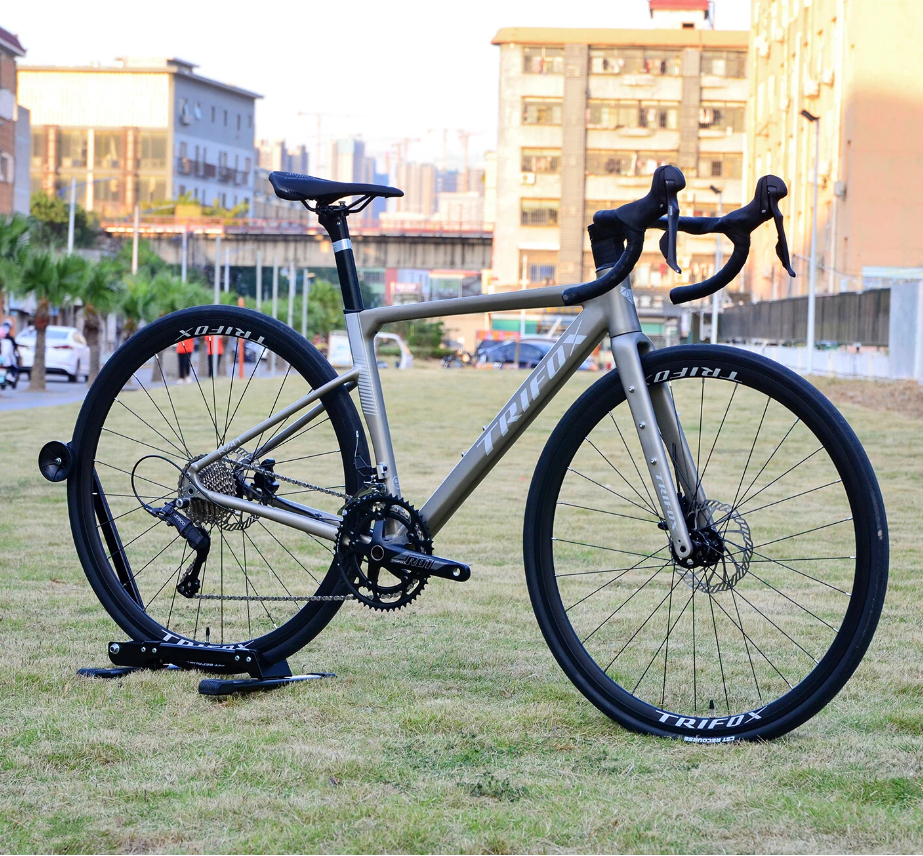
The Ideal Balance of Performance and Control
For beginners seeking their first serious road bike, the 22-speed drivetrain offers versatility across various terrains. Whether you're tackling steep hills or enjoying flat sprints, the wide gear range ensures you'll always have the right cadence. Paired with reliable disc brakes that provide consistent stopping power in all weather conditions, this setup builds confidence for new riders. The aluminum road bicycle frame delivers the perfect blend of durability and responsive handling, making it one of the good road bikes for beginners who want to progress quickly.
Why Aluminum Frames Make Excellent Starter Bikes
Aluminum frames have long been the go-to choice for entry-level and intermediate riders, and for good reason. The Trifox R241 features a lightweight aluminum frame that offers exceptional stiffness and power transfer. This means more of your pedaling effort translates into forward motion, giving you that authentic racing bicycle feel without the premium price tag. As an affordable road bike, it delivers performance characteristics that rival more expensive models, making it the best beginner road bike for those wanting to experience true road cycling performance.
Disc Brakes: Safety and Reliability for New Riders
One of the most significant advantages of this configuration is the inclusion of disc brakes. Unlike traditional rim brakes, disc brakes provide superior modulation and stopping power, especially in wet conditions. For beginners still developing their bike handling skills, this added safety margin is invaluable. The consistent performance of disc brakes allows new riders to focus on building technique and confidence rather than worrying about braking efficiency.
The Perfect Platform for Growth
What makes the Trifox R241 particularly special is its ability to grow with you as your skills develop. The quality aluminum frame serves as a solid foundation that can accommodate future upgrades, while the 22-speed gearing provides enough range to challenge you as you become stronger and more confident. It's not just a beginner bike - it's a platform that will support your progression in the sport.
Exceptional Value Without Compromise
In the world of road cycling, it's easy to spend thousands on a high-performance machine. However, the Trifox R241 demonstrates that you don't need to break the bank to get a quality ride. As one of the most affordable road bikes with premium features like a alloy 6061 fork and disc brakes, it offers tremendous value. The alloy fork specifically helps dampen road vibrations, adding comfort to your rides without sacrificing the responsive nature of an aluminum road bicycle.
Ready for Your Cycling Journey
Starting your road cycling adventure with the right equipment sets the tone for your entire experience. The 22-speed disc brake aluminum road bike represents the sweet spot for newcomers to the sport - capable enough to handle serious riding, forgiving enough to build confidence, and affordable enough to get you started without second thoughts. It's the best beginner road bike choice for those who are serious about developing their cycling skills while enjoying every mile.
The Trifox R241 combines all these elements into a package that's ready to roll. Whether you're looking to join group rides, tackle your first century, or simply enjoy the freedom of road cycling, this bike provides the perfect starting point for your journey on two wheels.
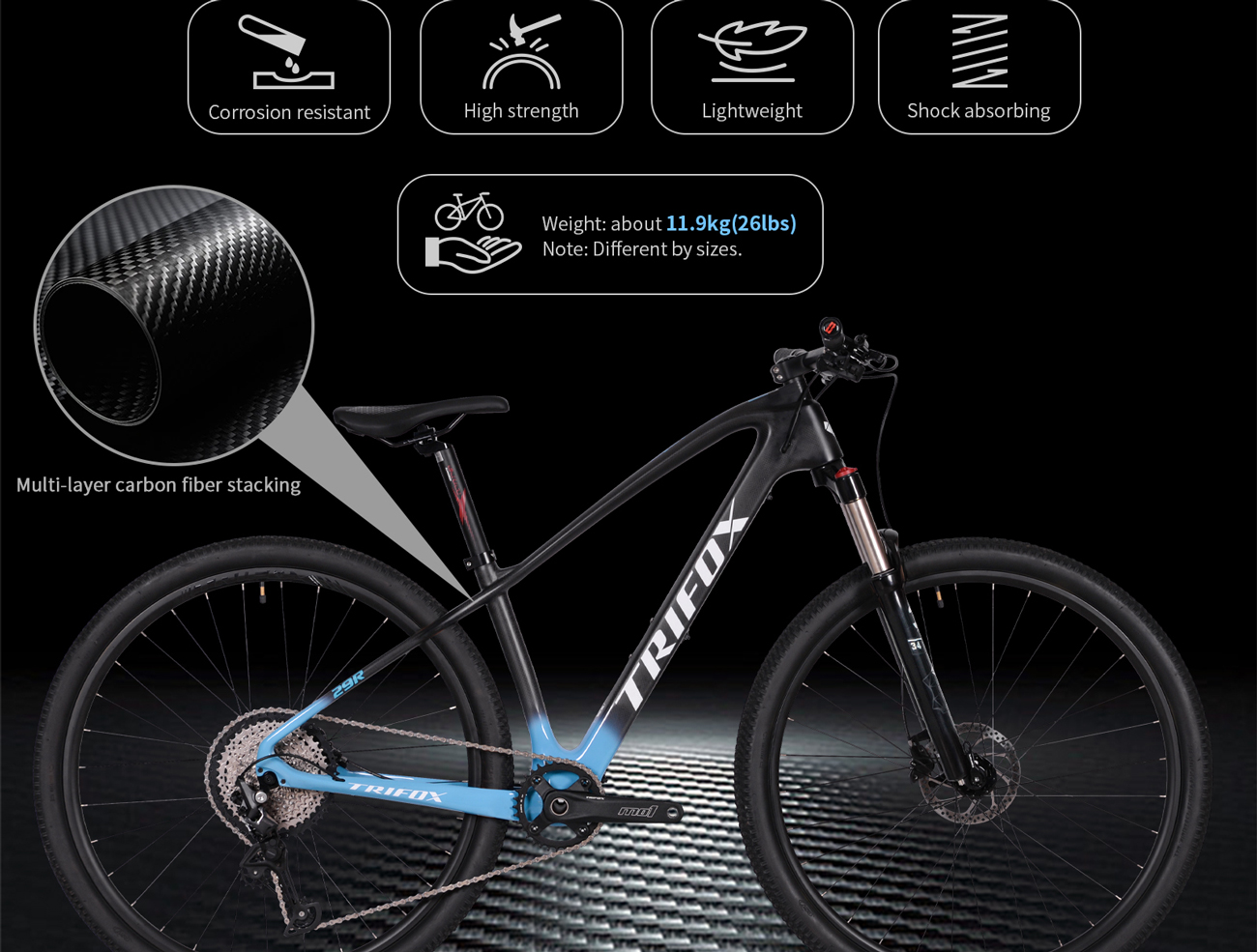
You see "T800 carbon" touted in bike specs, often positioned between "entry-level" T700 and premium "high-modulus" (like T1000+). But what does it actually mean, and is it good?
Here's the breakdown:
1. What "T800" Means: It refers to the tensile modulus of the carbon fiber strands (measured in Gigapascals - GPa). T800 fiber has a higher modulus (stiffer) than T700, but lower than ultra-high-modulus fibers like T1000 or T1100. Higher modulus generally means stiffer and stronger fibers for their weight.
2. The Benefits:
Improved Stiffness-to-Weight Ratio: Compared to T700, T800 allows frame designers to use less material to achieve the same stiffness, or make a frame stiffer at the same weight. This translates to better power transfer and responsiveness.
Good Strength: T800 offers excellent strength, crucial for durability and impact resistance.
Balanced Performance: It hits a sweet spot between the relative affordability/forgiveness of T700 and the extreme stiffness (and often higher cost/brittleness potential) of higher modulus fibers.
3. The Reality Check:
Layup is KING: The raw fiber grade is only part of the story. How the fibers are oriented, woven, layered (the "layup"), and bonded with resin determines the frame's final ride quality, strength, weight, and compliance. A genius layup with T700 can outperform a poor one with T800.
Not All T800 is Equal: Quality control in fiber production and frame manufacturing is paramount. Reputable brands ensure consistency; cheap frames might use "T800" but with questionable processes.
Higher Modulus ≠ Always Better: Ultra-high-modulus fibers (T1000+) can be too stiff, leading to a harsh ride. T800 often provides a better balance of stiffness and some vertical compliance (comfort).
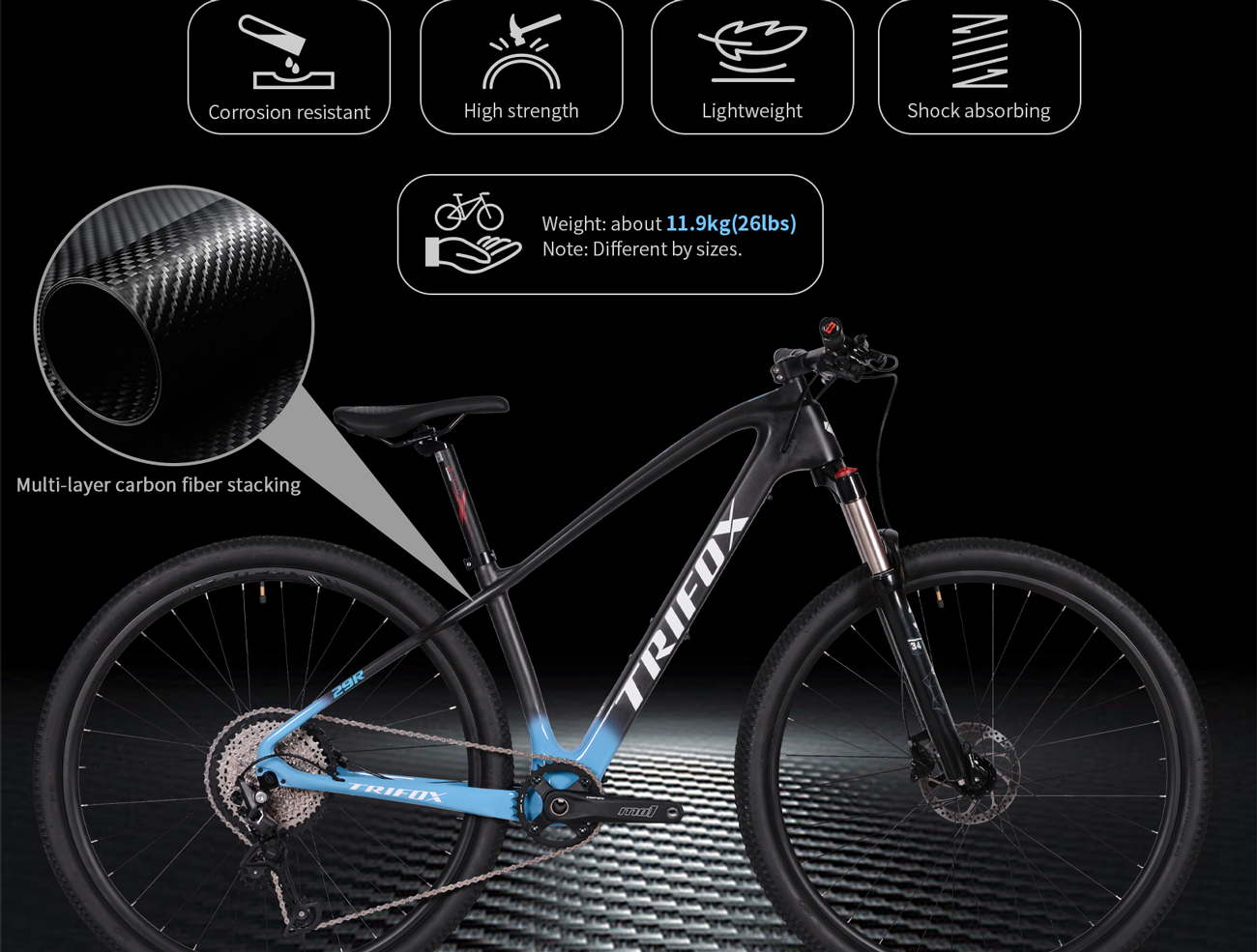
Verdict:
T800 carbon is a very good, high-performance material commonly found in quality mid-range to high-end road, gravel, and MTB frames. It offers a significant step up from basic T700 in terms of stiffness and efficiency without necessarily venturing into the ultra-stiff (and potentially less comfortable or more expensive) realm of top-tier moduli.
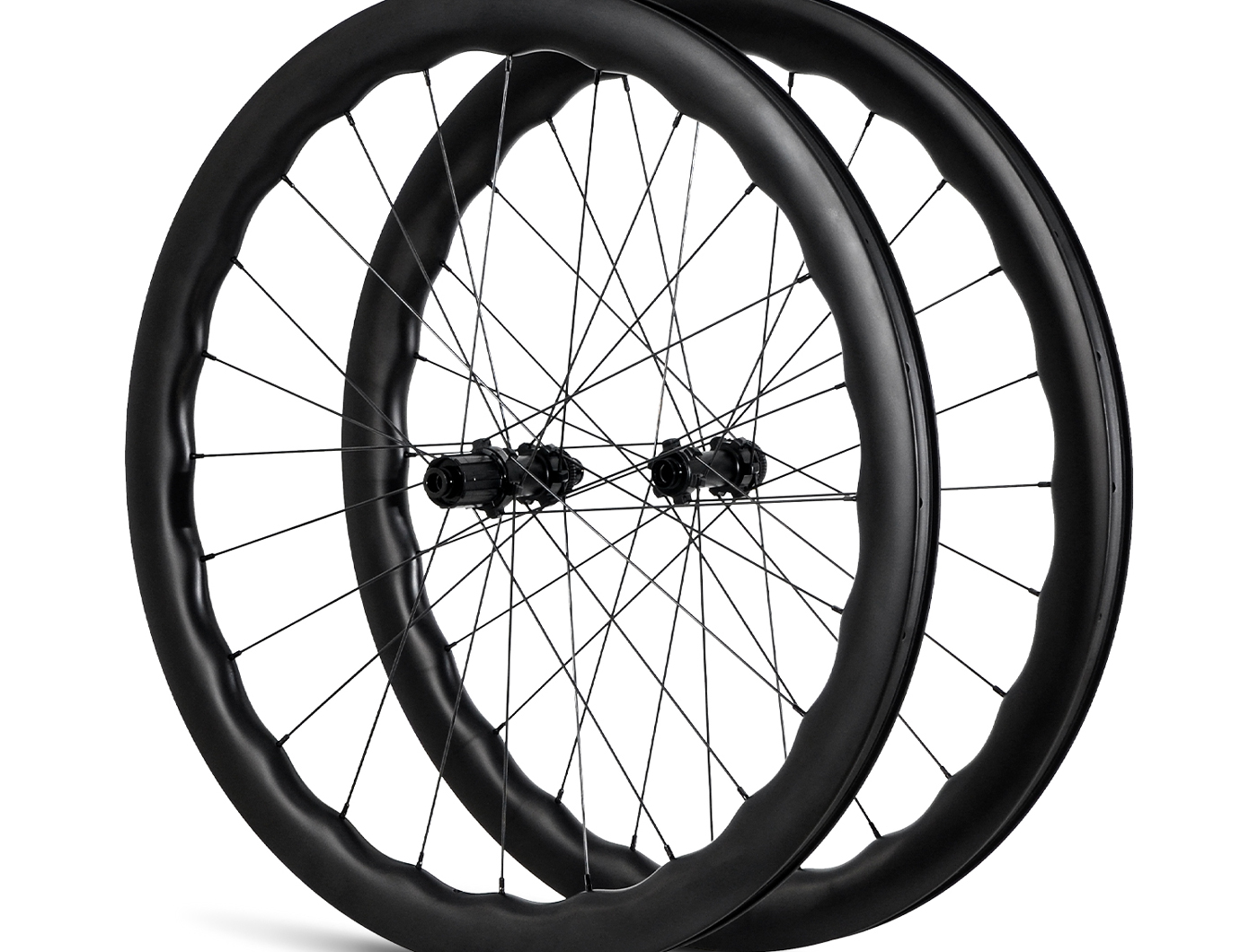
Upgrading to carbon wheels is a significant investment, but the performance gains are often transformative, not just incremental. Here’s how they change your ride:
1. Weight Savings = Acceleration & Climbing Magic:
Rotational Weight Matters Most: Shedding weight from the wheels (especially the rim) makes a HUGE difference. Lighter rims accelerate faster and climb easier because you're spinning mass, not just carrying it. You feel this instantly when sprinting or attacking hills.
2. Stiffness = Precision & Power Transfer:
Lateral Rigidity: Carbon rims resist flex under hard pedaling and cornering forces. This translates to:
Sharper steering response.
More direct power transfer (less energy lost to flex).
Increased confidence railing corners and pumping terrain.
3. Aerodynamics = Free Speed (Especially Cruising):
Smoother Airflow: Well-designed carbon rims slice through the air more efficiently than boxy aluminum counterparts. This reduces drag noticeably at sustained speeds above ~18-20mph, saving watts on flats and rolling terrain.
4. Vibration Damping = Smoother Ride & Reduced Fatigue:
Material Properties: High-quality carbon layups can absorb high-frequency trail buzz better than aluminum. This reduces hand, arm, and body fatigue on long, rough rides, improving comfort and control.
5. Strength & Durability (When Done Right):
Modern Engineering: Contrary to myths, properly built carbon wheels (from Trifox brands) are incredibly strong and impact-resistant. They excel at handling sharp hits and offer excellent fatigue resistance compared to aluminum.
The Caveats:
Braking Performance: Requires specific resin brake pads and proper bedding-in. Wet-weather performance can still lag slightly behind top aluminum.
Impact Sensitivity: While strong, massive, square-edge hits can cause damage aluminum might dent instead. Ride style and terrain matter.
Diminishing Returns for Casual Riders: The gains are most pronounced for fit, experienced riders pushing their bikes.
Who Feels the Biggest Difference?
- Climbers & Accelerators: Feel the weight savings instantly.
- Aggressive Trail/Enduro/DH Riders: Appreciate the stiffness and damping on rough descents.
- XC & Gravel Racers: Benefit from weight, aero, and stiffness efficiency.
- Riders Seeking "Ride Feel": The damped, lively, precise sensation is unique.
Carbon wheels make a substantial, multi-faceted difference. They are lighter, stiffer, often more aerodynamic, and can provide a smoother, more controlled ride. While expensive, they deliver tangible performance benefits that significantly alter how the bike feels, accelerates, climbs, and handles. For riders prioritizing performance and willing to invest, the upgrade is often considered one of the most impactful you can make.


























































